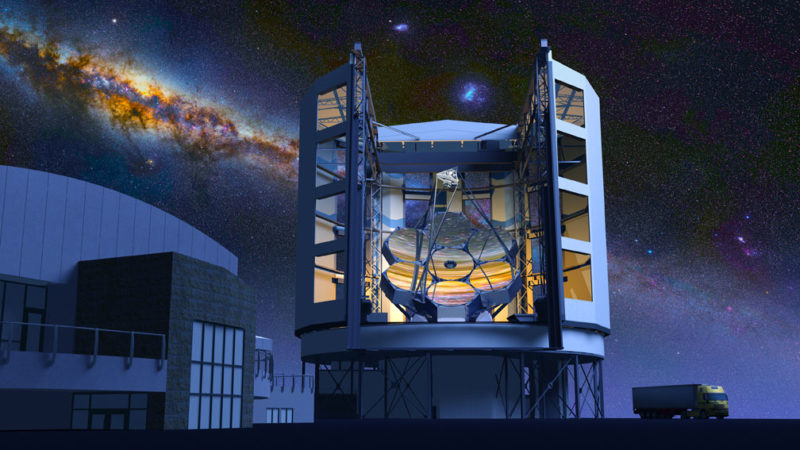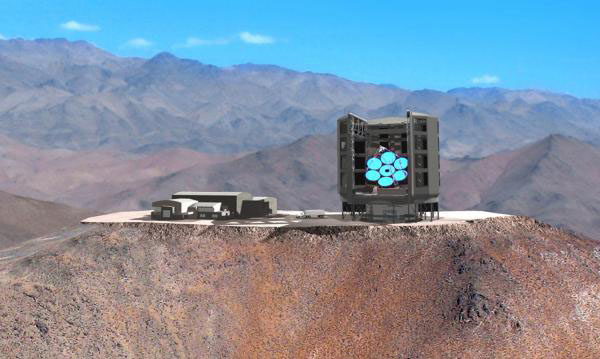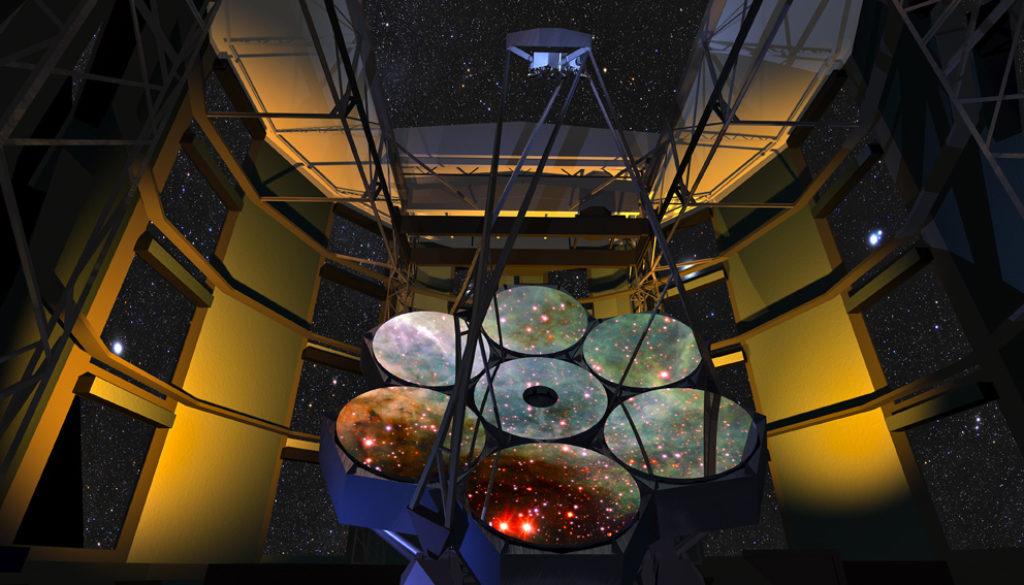Texas A&M Reaffirms Support to Help Build Giant Magellan Telescope
The Texas A&M University System Board of Regents has authorized the execution of an amended and restated Founders’ Agreement and Commitment Agreement with the GMTO Corporation, reaffirming Texas A&M University’s support to assist in building the Giant Magellan Telescope (GMT) and helping to pave the way for construction to begin in Chile later this spring.
“This investment ensures that Texas A&M astronomers play key roles in breakthrough discoveries that will redefine the fields of astronomy and astrophysics,” said John Sharp, chancellor of the Texas A&M System. “Support for this important endeavor gives us a major boost toward establishing Texas A&M as a top institution in national and international astronomical research and instrumentation.”
The GMT, set for construction at the Las Campanas Observatory site in the Atacama Desert in northern Chile, will be a member of the next class of super giant Earth-based telescopes that promises to revolutionize our view and understanding of the universe. When completed, the 25-meter colossus will feature 10 times the resolving power of NASA’s Hubble Space Telescope and more than six times the light-gathering area of the largest telescopes in existence today.
“This a major scientific step forward for us — and eventually for mankind as we seek to learn more about the vast universe in which we live,” said Texas A&M Interim President Mark A. Hussey. “In taking this big next step, we are ever mindful of the support that the late George P. Mitchell and his family gave Texas A&M in this ambitious endeavor, and we continue to marvel at his visionary efforts on all fronts. Also, we are especially pleased to move forward with this commitment at a time when we have as one of our Texas A&M University Institute for Advanced Study Faculty Fellows, Dr. Ed Moses, who serves as president of the Giant Magellan Telescope Organization.”


Australian National University astronomer Brian Schmidt, co-recipient of the 2011 Nobel Prize in Physics, describes the GMT as “predicated on modern technology,” merging lasers with an adaptable optics system that hinges on state-of-the-art astronomical instrumentation, including first-light instruments being built at Texas A&M. Whereas Hubble’s primary mirror is eight feet in diameter, the GMT’s will measure more than 80 feet. At 10 times the diameter of the Hubble, it also will make images of things such as distant planets transiting in front of stars 10 times as sharp. When completed, the GMT’s enclosure will stand 22 stories tall and encompass an area the size of three football fields.
“Thanks in part to our contributions, the GMT will be the first of the next generation of extremely large telescopes, enabling Texas A&M to help lead the future development of astrophysics,” said Dr. Darren DePoy, a Texas A&M astronomer since 2008 and one of Texas A&M’s representatives on the GMT Board of Directors along with Dean of Science H. Joseph Newton. “The vote affirms our commitment to the GMT, which will secure the future of astronomy at Texas A&M.”
Armed with the GMT’s unparalleled insights into optical and infrared astronomy not possible using current technology, scientists hope to unravel new details about the mysteries of dark matter and dark energy by using the GMT as a “time machine” to peer back into the cosmos to detect the origins of the very first stars and galaxies.
“With the commitment by the Board of Regents, we are fulfilling the legacy of George Mitchell, whose generous support in the earliest stages of the telescope project allowed the GMT to move forward,” said Dr. Nicholas B. Suntzeff, university distinguished professor of physics and astronomy and director of the Texas A&M astronomy program since 2006. “It was the vision of Mr. Mitchell and his family that astronomy would come to Texas A&M University, and our partnership in this project — one of the largest telescopes in the world — assures the future of Texas A&M as one of the premiere institutions in astronomical research. This is a big day for astronomy at Texas A&M!”
The GMT is expected to unlock the secrets of the very early universe — the first stars, galaxies and black holes that formed — and to give perhaps the first definitive answer as to whether or not there is life beyond Earth. Because it will be located in one the highest and driest locations on Earth, the GMT will offer spectacular observing conditions for more than 300 nights a year.
“The A&M System’s Board of Regents vote will enable Texas A&M scientists to lead exciting projects like the characterization of the first galaxies to form and measurements of atmospheres of planets around other stars,” DePoy said. “Because we have also been selected to lead the construction of key initial instruments for the telescope, we will have the opportunity to be among the first to use the massive telescope for science, ensuring that the Texas A&M astronomy program will be among the world’s finest.”
The bulk of Texas A&M’s GMT-related funds to date — $16.1 million — has been provided by 1940 Texas A&M distinguished petroleum engineering graduate George P. Mitchell ’40. Arguably one of the earliest and most enthusiastic driving forces behind the GMT during its first decade. Mitchell has committed a total of $33.25 million thus far to the transformational project in combination with his wife, Cynthia Woods Mitchell, and the Cynthia and George Mitchell Foundation. Beyond the couple’s $1.25 lead gift in 2004 that established Texas A&M as a founding partner, that total includes $500,000 toward first-mirror polishing, an additional $1.5 million in 2006, another $5 million in 2010 and, most recently in 2011, a $25 million gift credited equally to Texas A&M and to the Carnegie Institution for Science. In recognition of the Mitchells’ visionary support, the GMT’s first two mirrors — known as GMT1 and GMT2 and currently packaged at the University of Arizona’s Steward Observatory Mirror Lab in preparation for eventual transport to Chile — are named for George P. and Cynthia Woods Mitchell, respectively.
“I know that Mr. Mitchell would be thrilled with Texas A&M’s commitment,” said Dr. H. Joseph Newton, dean of the College of Science and inaugural holder the George P. Mitchell ’40 Chair in Statistics. “I am so pleased that the partnership of such a man of vision with his beloved Texas A&M will lead in a few years to the greatest viewing instrument ever dreamed of by mankind.”
In addition to Texas A&M, founding partners in the international consortium, managed by the non-profit GMTO Organization (GMTO), include Astronomy Australia Ltd., the Australian National University, the Carnegie Institution for Science, Harvard University, the Korea Astronomy and Space Science Institute, the Smithsonian Institution, the University of Arizona, the University of Chicago, the University of Texas at Austin and the Universidad de São Paulo. To date, more than $500 million has been raised in support of the GMT, including most recently in December, a $20 million gift from Interface Inc. founder and chairman Richard Caris to support Arizona’s participation.
Preparations currently are underway for the GMT’s fourth primary mirror casting, set for later this spring at Arizona’s Steward Mirror Lab — an important milestone that will render the telescope operational if needed, thanks to flexibility in its design that will allow for it to function even as the rest of the mirrors still are being fabricated.
For more information on the GMT or the upcoming mirror casting event, go to http://gmto.org.
To learn more about Texas A&M astronomy or the group’s participation in the GMT or other international projects, visit http://astronomy.tamu.edu.
# # # # # # # # # #
About Research at Texas A&M University: As one of the world’s leading research institutions, Texas A&M is at the forefront in making significant contributions to the storehouse of knowledge, including that of science and technology. Research conducted at Texas A&M represented annual expenditures of more than $820 million in FY 2013, ranking Texas A&M in the top 20 of the National Science Foundation’s most recent survey of research and development expenditures among U.S. colleges and universities. Recently reported FY 2014 research expenditures exceed $854 million. That research creates new knowledge that provides basic, fundamental and applied contributions resulting in many cases in economic benefits to the state, nation and world. To learn more, visit http://research.tamu.edu.
-aTm-
Contact: Shana K. Hutchins, (979) 862-1237 or shutchins@science.tamu.edu or Dr. Darren DePoy, (979) 862-2082 or depoy@physics.tamu.edu
The post Texas A&M Reaffirms Support to Help Build Giant Magellan Telescope appeared first on Texas A&M College of Science
